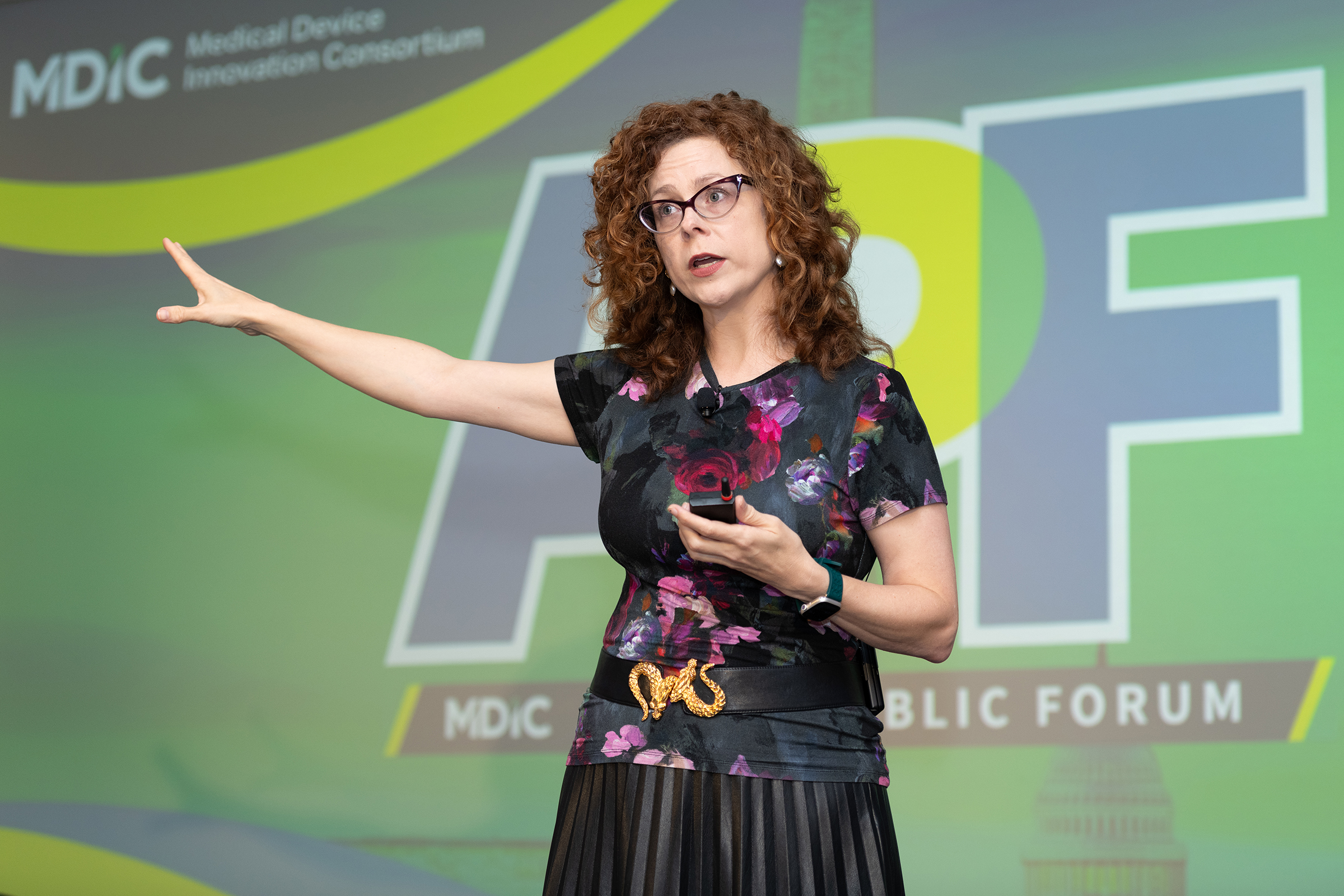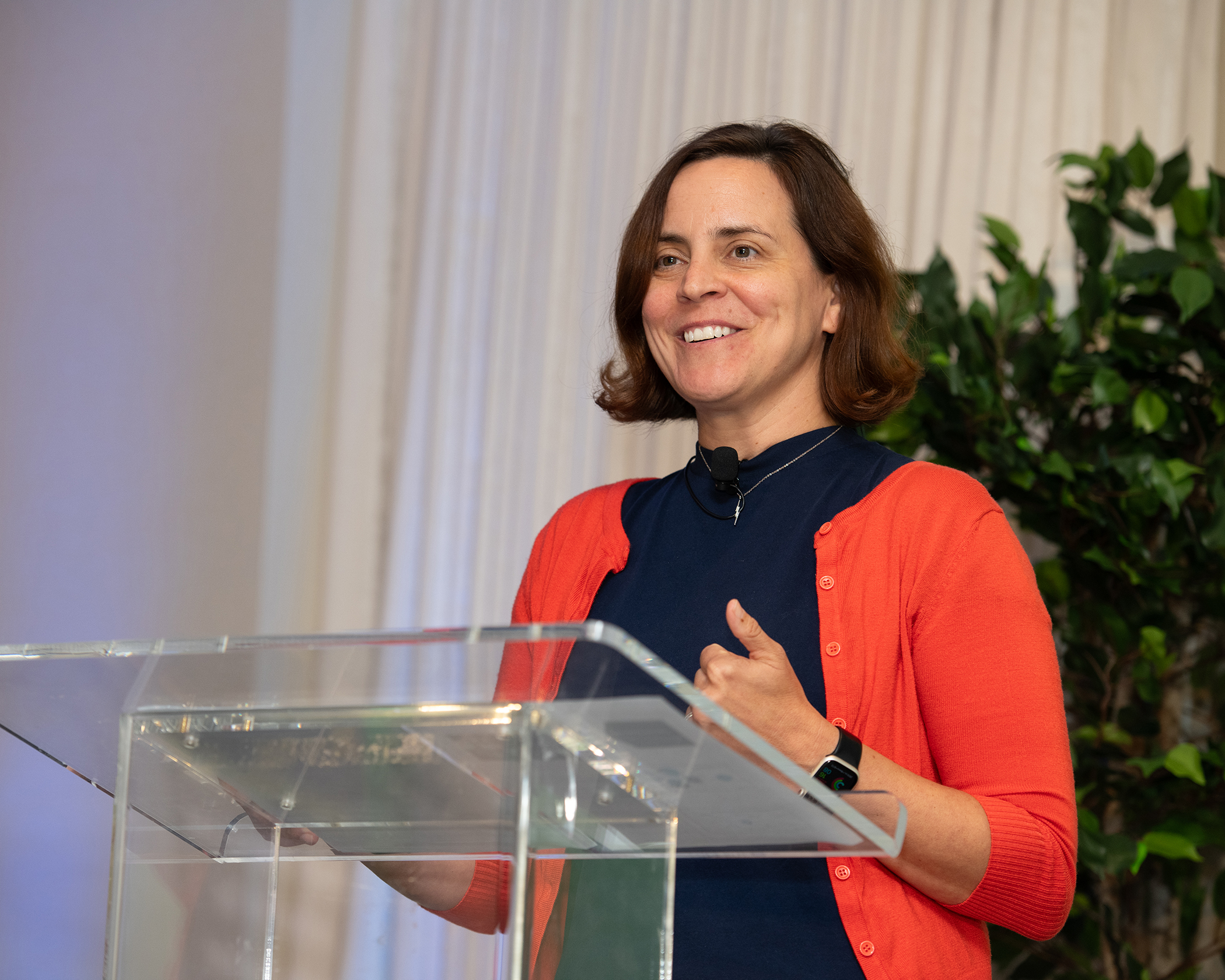Only in the last decade has the global community started to tackle inequities for women in healthcare, from equal representation in clinical trials to reduced mortality. This increased focus is a welcome step toward innovation that moves beyond male biology as a ‘norm’— yet a one-size-fits-all approach misses the mark when it comes to representation of diverse populations. At the MDIC Annual Public Forum experts in women’s health convened to discuss these persisting inequities in health and to share visions of potential pathways to more targeted, effective, and equitable care.
The Evolution of Female Biology in Medicine
Cat Bohannon, author of Eve: How the Female Body Drove 200 Million Years of Human Evolution, centered her keynote on the intricate biology of women, interrogating how overlooking the distinctions of female anatomy has historically shaped healthcare. “For decades, we did not include females in clinical trials because we didn’t want to ‘mess up the babies.’ But the truth is, women’s bodies are metabolically distinct, and that affects everything from opioid metabolism to anesthesia,” Bohannon emphasized.

NYT Best-selling Author Cat Bohannon at the MDIC Annual Public Forum.
The exclusion of women from decades of research has left gaps that still impact how treatments are developed today. Bohannon discussed how this oversight in clinical trials complicates women’s pain management during surgery and childbirth, areas where tailored approaches could significantly improve recovery times and patient experience. Ignoring disparities between the sexes can restrict progress in medicine, she argued, and make women susceptible to less successful— and even harmful—treatment options.
In their fireside chat, Bohannon and Sheri Dodd, CEO of Tactile Medical, discussed the direct impact of sex-specific anatomy on medical device design. Dodd shared an eye-opening example: “We’re still lacking in devices that have been developed for physiological risks to women, such as pelvic floor injuries from delivering a baby. These risks are not adequately accounted for.” She underscored the necessity of proactive design, “We need to design devices with women in mind from the outset, not as an afterthought. It’s crucial that we close this gap.” The conversation illuminated a critical obstacle in product development: the lack of the advanced technology needed to holistically improve outcomes for women during labor and postpartum recovery.
ARPA-H’s Approach to Women’s Health Innovation
Dr. Renee Wegrzyn, director at ARPA-H, shared that the agency is focusing on the development of research that contributes to the improvement of therapeutic outcomes for women at all life stages.
In her keynote, Dr. Wegrzyn challenged traditional medical assumptions about ovarian failure, questioning the inevitability of such decline. She proposed exploring new strategies to prolong ovarian function and prevent menopause-related health issues, including stem cell therapies and other innovative approaches to maintain or rebuild hormonal balance to reduce the negative symptoms associated with menopause. Dr. Wegrzyn emphasized the role of the preventive model in women’s health and urged healthcare systems and institutions to invest in prevention initiatives.

Dr. Renee Wegrzyn, director at ARPA-H, at the MDIC Annual Public Forum.
Dr. Wegrzyn then stressed the need for healthcare accessibility, particularly for those in rural areas. She highlighted the use of technology to facilitate home-based care: “We’re working to bring healthcare into the home—especially for those who are 300 miles away from the nearest clinic and can’t take time off from work or family responsibilities to attend routine appointments.” ARPA-H is working with partners to create a mobile platform that can deliver a myriad of next-generation services including multi-cancer screening, haemodialysis, perinatal care, and more, to women in need.
Dr. Wegrzyn’s discussion underscored the comprehensive and dynamic approach ARPA-H is taking to address the understudied aspects of women’s health. ARPA-H’s impact is projected to bring down healthcare costs for women and enhance health outcomes through early diagnosis. By pushing the boundaries of medical research and application, the initiative ensures that future healthcare innovations are as inclusive as they are groundbreaking.
Addressing Systemic Gaps in Women’s Health
Dr. Wegrzyn then joined a panel discussion with Kathryn Godburn Schubert, president & CEO of the Society for Women’s Health Research, Linda Goler Blount, president of the Black Women’s Health Imperative, and Tracy MacNeal, president and CEO of MaternaMedical. Moderated by Esther Krofah, executive vice president at Milken Institute Health and MDIC board member, the experts examined the structural inadequacies of the current healthcare system and how organizations can address broader issues of equity and access in underserved communities.

Esther Krofah, Executive Vice President at Milken Institute Health and MDIC Board Member, moderates panel of women’s health experts at the MDIC Annual Public Forum.
MacNeal emphasized how the CMS fee-for-service (FFS) model, which pays providers for the volume of services they deliver, can create challenges in remote areas where healthcare resources are limited and travel distances are long. She stated, “In rural Georgia, where patients must travel two hours for a prenatal visit, the urgency to deliver technology directly to the community is critical. This challenges us to rethink how healthcare is structured.” By shifting focus to long-term and preventive care, we have the potential to positively impact the long-term trajectory of the healthcare needs in these communities. MacNeal advocated for a shift to value-based care models that prioritize patient outcomes and support sustainable healthcare practices, particularly in underserved areas where the current system can perpetuate access and quality disparities.
Godburn Schubert continued to stress the importance of addressing marginalized and underserved communities. She shared that clinical trial participants are “mostly white women, and they’re mostly of a certain age. We are still missing significant data on minority women and younger demographics.” Linda Goler Blount echoed this, pointing out that “the number one reason Black women don’t participate in clinical trials isn’t mistrust—it’s because they’re not asked,” adding that “Black women who drop out [of clinical trials] do so due to disrespect or feeling devalued.” Blount cautioned that evidence generated without diverse participation leads to inequitable healthcare, as seen during the pandemic when pulse oximeters were less efficient for people of color. She called on health system leaders to ensure that employees who work on clinical trials are trained in cultural sensitivity, leading to participants feeling more respected and counteracting system-based barriers to promote more representative and effective clinical trials.
Dr. Wegrzyn reinforced the economic case for women’s health innovation, noting that closing the gender gap in healthcare could add trillions to the global economy by 2040. “If we invest just $300 million more in women’s health research, we could generate an economic return of $13 billion,” she shared, emphasizing not only the health benefits but also the financial incentives for addressing women’s health needs proactively.
The Case for Centering Women’s Health
The discussions at the MDIC Annual Public Forum underscored the ongoing need to place women’s health at the forefront of medical device innovation. Participants unpacked the pros and cons of the buzz around “FemmeTech” and made a strong case for the comprehensive benefits—societal, economic, and beyond—of shifting the unique healthcare needs of women to the fore, not treating them as an afterthought. They urged MDIC’s diverse group of collaborative stakeholders to prioritize inclusive and culturally sensitive practices at every patient touchpoint, especially in early-stage clinical trials, and to make long-term investments in developing solutions for historically underserved areas of women’s health such as childbirth and menopause. The potential impact of adopting a women-centric lens when envisioning the horizon of the healthcare ecosystem is immeasurable; attendees were left with the challenge to see themselves as part of moving the needle.

